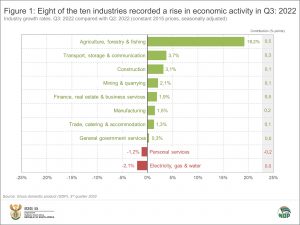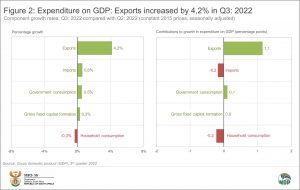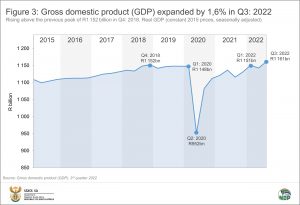South African GDP grows by 1,6%
After contracting by 0,7% in the second quarter of 2022, the economy rallied in the third quarter, expanding by 1,6%.1 The agriculture, finance, transport and manufacturing industries were the main drivers of growth on the supply side of the economy. The demand side of the economy was lifted by a rise in exports and government consumption.
The size of the economy now exceeds pre-pandemic levels. Real gross domestic product (GDP), measured by production, was R1 161 billion (constant 2015 prices) in the third quarter, which is above the previous peak of R1 152 billion recorded in the fourth quarter of 2018.
Agriculture, finance and transport help push GDP higher
Eight of the ten industries recorded an increase in economic output in the third quarter of 2022 (Figure 1). Agriculture, forestry & fishing was the largest positive contributor, increasing by 19,2%. This was mainly associated with a rise in the production of field crops and horticulture products.
The finance, real estate & business services industry was the second largest positive contributor, expanding by 1,9%. Because this is the largest industry in the economy (contributing almost a quarter of value added), a change in its fortunes typically has a noticeable impact on GDP. Growth in the third quarter was driven by financial intermediation, insurance & pension funding, auxiliary activities, and real estate & other business services.
Transport, storage & communication expanded on the back of increased economic activity in land transport, transport support services and communication services.
The manufacturing industry was also a significant positive contributor. Output was bolstered mainly by the automotive sector, food & beverages, and metal products.
On the downside, the personal services and electricity, gas & water supply industries contracted in the third quarter.
Exports and government consumption drive up expenditure on GDP
Stats SA also measures the expenditure side of GDP, providing an indication of total demand in the economy. This includes measures of household consumption, government consumption, investment (gross fixed capital formation and changes in inventories), and net exports.
Exports increased by 4,2% in the third quarter (Figure 2), driven mainly by increased trade in mineral products, metals, vegetable products and paper products. The rise in government consumption was led by increased spending on goods and services.
Economic recovery from COVID-19
The pandemic hindered economic growth for about two years. Real GDP reached pre-pandemic levels in the first quarter of 2022 (Figure 3). The recovery was brief, with GDP contracting by 0,7% in the second quarter, mainly the result of widespread flooding in KwaZulu-Natal.
Not only does the 1,6% rise in the third quarter boost the economy back above pre-pandemic levels, but quarterly real GDP is now the highest it’s ever been, exceeding the previous peak of R1 152 billion recorded in the fourth quarter of 2018.
For more information, download the latest GDP release, media presentation and Excel files here.
1 The quarter-on-quarter rates are seasonally adjusted and in real (volume) terms (constant 2015 prices).
Similar articles are available on the Stats SA website and can be accessed here.
For a monthly overview of economic indicators and infographics, catch the latest edition of the Stats Biz newsletter here.




